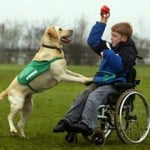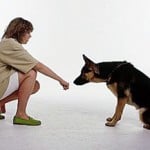Service dog training involves the training of a dog for specific purposes to assist someone in need either in the home or in public. There are several kinds of service dogs. Mobility assistance and seeing-eye are the most recognized. In recent years, there has been an expansion to include seizure alert, hearing assistance, emotional therapy, and autism assistance.
Dog Behavior & Training
Learn How to Stop Dog Whining
Dogs whine to express different conditions or states of mind. We need to understand under what conditions most whining occurs before we can worry about stopping it. Whining is always a form of communication; we just need to be able to understand it. There are some breeds that are more likely to whine. Anyone that has ever lived with a German Shepherd Dog knows they are big fans of whining! Huskies and Basenjis are known to whine and yodel too. Dogs that whine a lot may do it more so than barking, and they can be quite expressive in their efforts.
How to Stop a Dog From Chewing
A lot of people think that a dog that chews things is either terribly bored or simply trying to be vindictive. They’re wrong. This is one of the most common problems when it comes to dogs and undesirable behavior. But it’s also not as straightforward as many dog owners think. Humans play solitaire to keep themselves occupied when they’re alone. Dogs chew. It’s what they do.
Dealing With Your Dogs Separation Anxiety
Some dogs just naturally seem more anxious all the time than other dogs, but this is something quite different. To determine whether this is indeed a case of separation anxiety and not just a case of Trixie trying to ease her own stifling boredom, ask yourself these questions:
Does she follow you from room to room when you are home?
How to Housebreak Both Puppies and Adult Dogs
Housebreaking a dog is not an easy task, but understanding a dog’s behavior is the first step required in any type of training. Dogs are predatory animals and hence, the basic behaviors of a dog, remain the same. There are certain rules that you must follow to control your dog’s actions. The best way is to adjust to your dog’s behavior and not being harsh on them.
Three Steps for Meeting a Dog – Instructions for Parents
It is very important to teach kids how to interact with dogs they are interested in. Childish excitement could be interpreted as a threat by inexperienced dogs. Good kids and good dogs will have miscommunications every day. By teaching children and dogs how to interact with one another, we laying the groundwork for happy, healthy relationships between them. Take time to help your child practice meeting a variety of dogs.
An Introduction To Clicker Training
There are many techniques you can use to teach your pet tricks or get them to act on their best behaviour. One technique that first gained popularity in marine animals is Clicker Training or Operant Conditioning. In the 1940’s this technique was used in a laboratory to study conditioning of man’s best friend, the dog. It was only made public with the use of marine animals to promote the effectiveness of the study and training method.
What To Do When Your Dog Has a Fighting Problem
If you have a dog that likes to fight other dogs, it can be a frightening and annoying experience just going for a simple mid-afternoon walk in the park. It’s important to know that you can train a dog to overcome his fighting instincts, and that your own personality needs to be strong to deal with fighters. You have to show him that you are the boss.
Teach Your Puppy to Sit and Stay Sitting
Puppies love to move. They wriggle, bounce, roll and jump until they exhaust themselves, then they wake up and do it all over again. The last thing Butterscotch wants want to do is sit still. Oh, she may do it on her own so she can stare at a butterfly or to ready herself before she launches herself at a chew toy, but to sit at your command? This is one of the three most important lessons you and your dog will learn together (along with Come and Stay), so it pays to master it well and soon.
Why Do Dogs Chase Their Tails
Typically, a dog chases its tail simply since it really is pleased, excited and energetic and such behaviour is actually a normal component of play. This really is similar to the human behaviour of tapping fingers, or whistling. It really is a release of power, and doesn’t constantly mean one thing is incorrect, but it can do if a dog does it excessively or over-anxiously.










